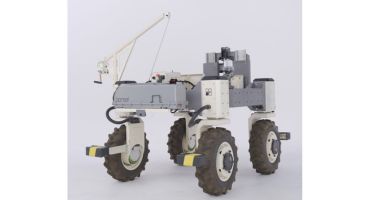Takeuchi’s First Wheeled Excavator Has Arrived After Delay
The 23,424-pound TB395W features a two-piece variable-angle boom and three auxiliary circuits for attachment versatility on tight...

Takeuchi’s first wheeled excavator, the TB395W, has officially hit the North American market, offering high travel speeds and the ability to tackle both on- and off-road applications.
It runs on a 114-horsepower Deutz engine capable of delivering up to 339 pound-feet of torque. When equipped with outriggers and a blade, the excavator weighs 23,424 pounds. A closed-loop, load-sensing hydraulic system delivers smooth control and the ability to run a wide range of hydraulic attachments, the company says.
The TB395W was unveiled at ConExpo 2023 and is now available to customers in the U.S. and Canada following a delay in the originally stated launch timeline of Fall 2023. To get a complete overview of the TB395W, check out Equipment World’s walkaround video with Takeuchi’s David Caldwell: Takeuchi's First Wheeled Excavator for the U.S., the TB395W.
[Related Content: The Overlooked Wheeled Excavator – They Do More Than You Might Expect]
Improving upon the model displayed at ConExpo, the latest iteration of the TB395W features 4WSC (four-wheel with crab steering) for added maneuverability on tight jobsites in addition to 2WS (two-wheel steering).
The two-piece boom with long arm provides greater clearance between the bucket and dozer blade, allowing operators to pull the bucket all the way back to the blade. An Auto Cruise feature lets operators set and adjust their travel speed with a toggle switch to maintain a consistent, repeatable travel speed.
The TB395W has a 13-foot 5-inch digging depth and a 27-foot cutting height. The wheeled excavator also offers a maximum bucket breakout force of 13,241 pounds, a maximum arm digging force of 8,925 pounds, and a traction force of 12,994 pounds.
Three auxiliary circuits allow operators to use a wide range of attachments. The primary circuit delivers 32 gallons per minute, the secondary provides 14.5 gpm, and the third auxiliary circuit is specifically designed for use with a hydraulic quick coupler.
Redesigned interior
A newly redesigned interior features an 8-inch color touchscreen monitor with a jog dial to navigate settings and control the integrated air conditioning and DAB radio functions. A standard 270-degree camera gives operators a birds-eye view of the jobsite for enhanced safety.
One-touch control switches operate other machine functions, such as work lights, Standard and Eco working modes, primary auxiliary detent, low- and high-speed gear box, swing boom/second boom select, differential lock, manual regen/regen inhibit and lift overload alarm.
A deluxe, high-back, air-ride suspension seat, adjustable arm rests, low-effort pilot controls, large flat floor area and integrated footrests also make for a comfortable operating experience.
Easy serviceability
Takeuchi says it designed the TB395W for easier serviceability. It has a wide-opening rear engine service door and a right-side cover that open overhead. The service door and right-side cover are also constructed of steel and lockable.
“We know from experience that machine owners are more likely to properly service and maintain their machines at the correct intervals when those tasks are simpler to perform,” said Lee Padgett, product manager for Takeuchi. “That’s why the TB395W’s design ensures easy access to key daily inspection points like the engine oil dipstick, engine oil filter, engine oil fill and more.”
Takeuchi’s standard Fleet Management (TFM) telematics system helps owners reduce downtime and control costs by providing machine health and condition data, runtime (hours) and machine location, as well as remote diagnostics, scheduled maintenance reminders, customizable alert settings and machine geofencing.
“As the world becomes increasingly urbanized, excavator owners and operators must frequently work on projects near city streets and other developed areas,” Padgett adds. “The new TB395W provides the power of a tracked excavator but with less disruption to existing infrastructure and the ability to travel efficiently from Point A to Point B.”

 machineryasia
machineryasia 




